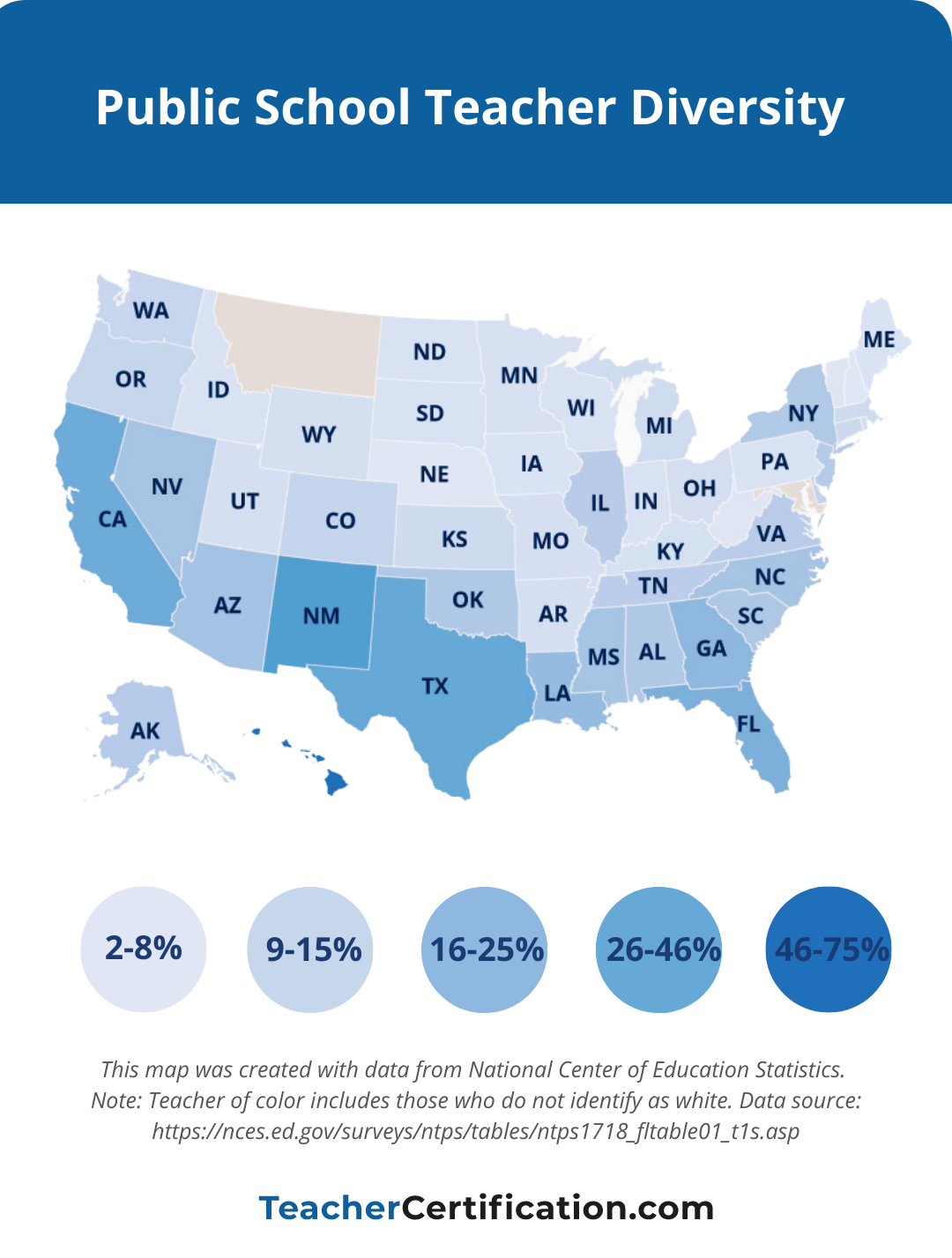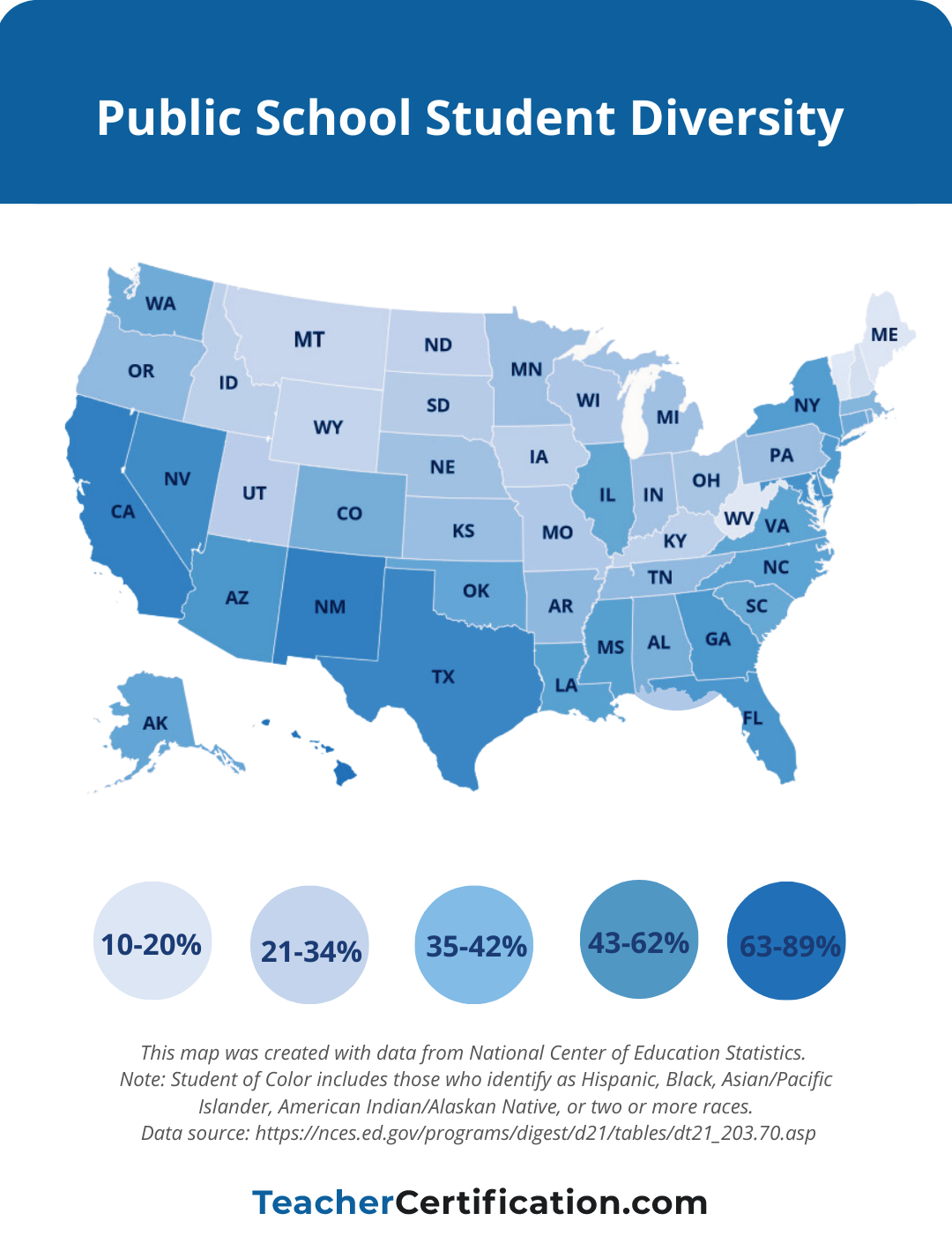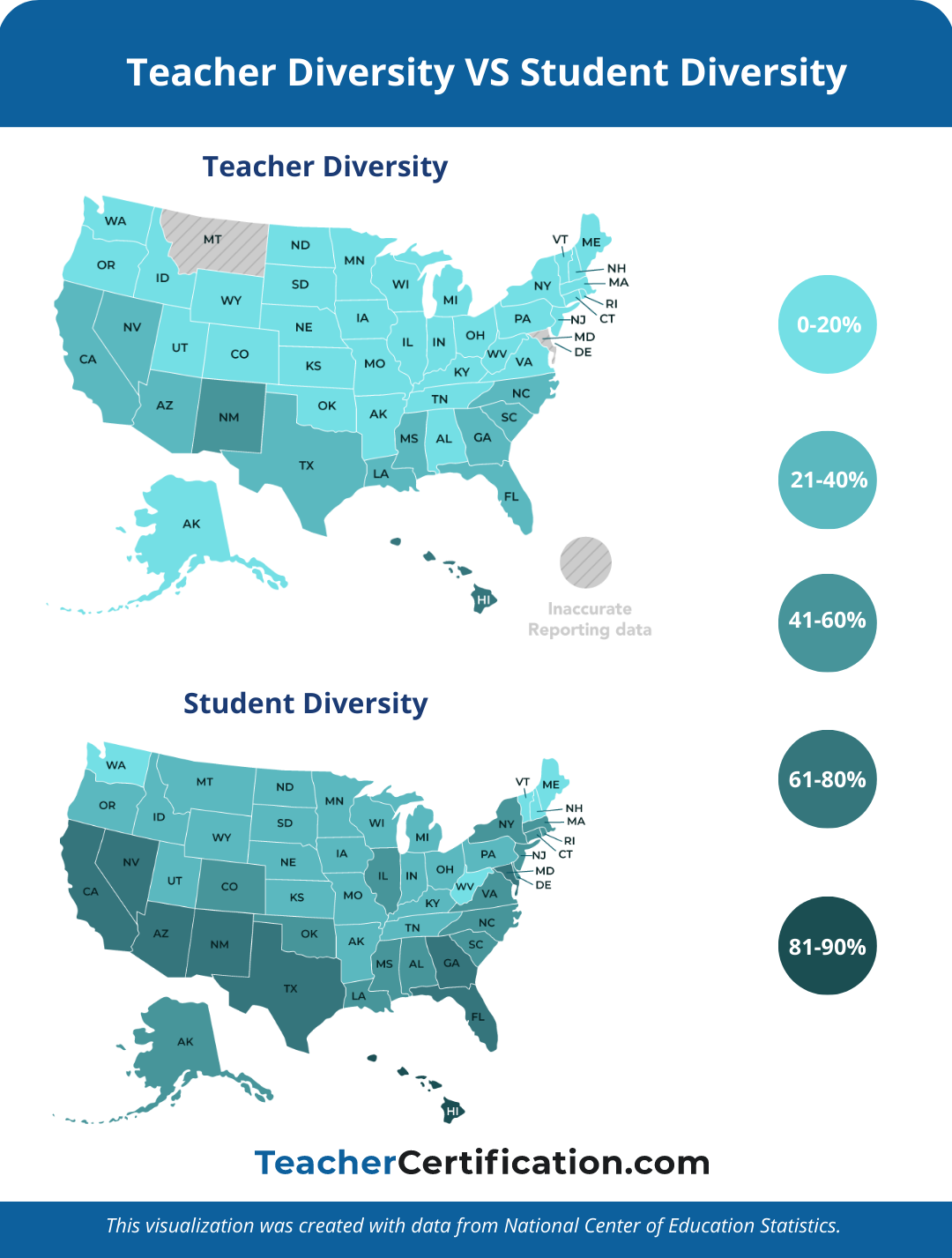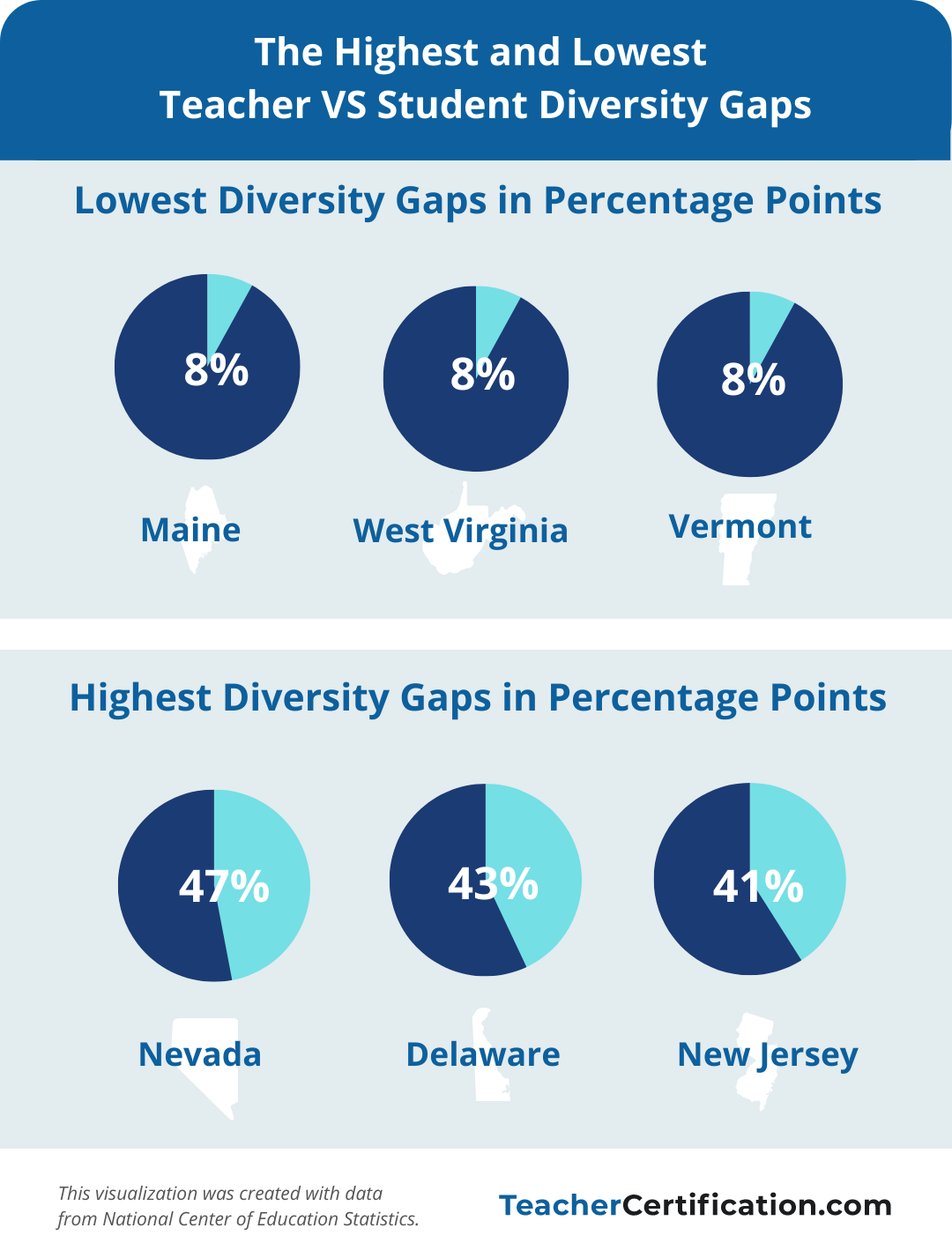Teacher and student diversity in the US: How diverse is your state?

Canva
Teacher and student diversity in the US: How diverse is your state?
A teacher oversees a classroom of diverse students.
The United States is a vibrant tapestry of racial and ethnic groups. However, the nation’s teaching workforce does not adequately represent the country’s cultural richness.
The latest data from the National Center for Education Statistics, which is from the 2017-2018 school year, reveals that around 21% of public school teachers are people of color. This contrasts with 48% of public school students who were white in 2017.
Studies show that having a same-race teacher can have a significant impact on students’ short and long-term success, yet even in states that have the most diverse teaching workforce, there remains a disparity between teacher and student diversity.
In this article, TeacherCertification.com delves into the ethnic diversity of teachers and students across the US. Here, diversity refers specifically to ethnic diversity, and the term “person of color” encompasses any educator or student who identifies as an ethnicity other than non-Hispanic white.
The Impact of Same-Race Teachers
The impact of same-race teachers on student outcomes is both significant and far-reaching.
The Tennessee STAR experiment illustrates this powerfully, revealing a 9 percentage point increase in high school graduation rates for Black students with at least one same-race teacher between kindergarten and third grade, as well as a 19 percentage point boost in college enrollment rates.
The book, “Teacher Diversity and Student Success – Why Racial Representation Matters,” emphasizes that factors such as higher expectations and a deeper cultural understanding on the part of same-race teachers contribute to improved outcomes for minority students. As a result, same-race teachers play a crucial role in bridging the achievement gap between minority and majority students.
![]()

TeacherCertification.com
Teacher racial diversity by state
A map showing states shaded in different colors depending on how diverse their public-school teaching staffs are.
On average nationally, 16% of public school teachers do not identify as white, according to the most recently collected data, from school year 2017-18.
The states that have close to the average number of teachers of color include Delaware at 14%, Tennessee with 17%, and both Virginia and Illinois at 18% each. New Hampshire, Nebraska, and Vermont are states that have the lowest teacher diversity with less than 3%.
On the other end of the spectrum with relatively high teacher diversity we have Georgia at 30%, Florida at 35%, California at 38%, and Texas at 40%. The highest teacher diversity is in New Mexico with 46% and Hawaii with 75%.
It is important to acknowledge that more population-heavy states such as California and Texas often exhibit greater diversity in their overall population. As a result, even if these states provide a more diverse teaching workforce, they may still face challenges in having teachers with backgrounds reflective and proportional to the multitude of ethnicities present within their student body.

TeacherCertification.com
Student racial diversity by state
A map showing states shaded in different colors depending on how diverse their public-school student bodies are.
In the U.S., the average public school has a student body that is around 45% non-white, according to 2020 data from the National Center for Education Statistics. This data includes students that identify as Hispanic, Black, Asian/Pacific Islander, American Indian/Alaskan Native, or two or more races.
States that fall close to the middle range in student diversity (40-50%) include states such as Tennessee with 40%, Alabama with 47%, Washington with 49%, and Connecticut with 50%.
At the low end of the student diversity spectrum, we have West Virginia and Vermont with around 11%, Maine with 12%, and New Hampshire with 16%.
Several states stand out with notably diverse public school students: Texas with 73%, California with 78%, New Mexico with 79%, and Hawaii with 89%.

TeacherCertification.com
Comparing teacher and student diversity by state
A pair of maps showing states shaded in different colors based on their percentages of teachers of color and students of color.
When looking at the link between teacher and student diversity, some patterns can be seen. In states with more diverse teachers, there are often more diverse students too. This is because these states have more diversity in their overall population, which leads to a bigger group of diverse teachers and students. Next, we will examine the diversity gaps, which highlight the disparities between the student population in public schools and their corresponding teacher demographics.
Every state shows a discrepancy between student and teacher diversity, with the student population consistently displaying more diversity than the educator workforce.
In fact, most states have more than 28 percentage points lower diversity levels of their teachers compared to students. These states include Florida, where 35% of public school teachers are non-white, but they teach a student body that is 64% non-white. The diversity gap – the difference between the teacher-student diversity – is even larger in Pennsylvania and Texas, where the state’s students are more than 30 percentage points more diverse than their teachers.

TeacherCertification.com
Diversity differences by state
A chart showing states where students and teachers’ diversities are most similar and most different.
Maine, West Virginia, and Vermont exhibit the smallest gap between student and teacher diversity, with a modest 8 percentage points lower teacher diversity than student diversity. Interestingly, Vermont and West Virginia also have the fewest teachers of color at less than 3%. Still, the student-teacher diversity gap remains low because the student population is also less diverse at around 11%.
These smaller states have lower diversity gaps because their overall population diversity is low. Data from the US Census Bureau shows that Maine is about 91% non-Hispanic white, while Vermont and West Virginia are both 90% non-Hispanic white. Public school students in these states reflect similar demographics.
Other states demonstrating a lower-than-average student-teacher diversity gap include New Hampshire with 14 percentage points, Wyoming with 16 percentage points, and Kentucky with 19 percentage points. These states also have relatively homogenous demographics with less than 18% identifying as other than non-Hispanic white.
The teacher-student diversity gap tends to be larger in states with higher overall diversity levels, like California (40 percentage points) and New York (39 percentage points). The most significant gaps in student-teacher diversity can be found in Nevada, with a striking 47 percentage points difference, followed by Delaware at 43 percentage points, and New Jersey with a 41 percentage points disparity.
Other states facing significant challenges in aligning their teacher diversity with student diversity include Washington (37 percentage points gap), Rhode Island (38 percentage points gap), and Connecticut and Arizona (both 39 percentage points gap). All these states have highly diverse populations and not enough teachers of color to represent the student body.
Conclusions
The disparities in diversity between teachers and students across the United States highlight the need for a more concerted effort to increase representation within the educator workforce. A diverse teaching force is essential in fostering an inclusive and equitable educational environment for all students, regardless of their racial or ethnic background.
Addressing the diversity gap between teachers and students is not only a matter of fairness but also a vital step in enhancing the quality of education and preparing the next generation for a diverse and globalized world.
This story was produced by TeacherCertification.com and reviewed and distributed by Stacker Media.





